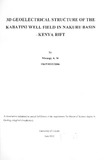| dc.description.abstract | Kabatini well field in Bahati area of Nakuru in the Kenya Rift, which has the highest yielding
boreholes that supply 80% of the water needs in Nakuru, was selected for the geophysical study
to obtain the electrical resistivity structure. Vertical electrical soundings (VES), electrical
resistivity tomography (ERT) were conducted in the Kabatini area. These methods involve
injecting of current into the ground and the flow of current is dependent on the pore fluid content
of the rock and salinity of the fluid. The resistivity method measures the apparent resistivity of
the subsurface, including effects of any or all of the following: soil type, bedrock fractures,
contaminants and ground water. Variations in electrical resistivity/conductivity may indicate
changes in composition, layer thickness or contaminant levels. The resistivity method is useful
for simultaneously detecting lateral and vertical changes in subsurface electrical properties. The
1 D vertical electrical sounding (VES) was used to obtain a 3D geoelectric structure. To do this
the data was collected in a uniform grid of 16 soundings and processed individually and plotted
using a 3D plotting software to give the aquifer dimensions. Electrical resistivity tomography, a
new technique in geophysics, widely used in environmental geophysics and engineering was
applied in the Kabatini well field. This method had not been applied to this well field before
hence was used to provide more information about the area. The results obtained from the
electrical resistivity tomography (ERT) complimented the VES results hence resolved the near
surface region. The near surface region of the aquifer showed that the main aquifer found at a
depth of about 60 meters is semi confined. In addition, the 3D model showed the aquifer is
structurally controlled and is recharged by a river flowing in a shallow channel and a deeper
channel. This indicates the fault structures control ground water movement in Kabatini. The
main objective of the methods was to map the subsurface resistivity distribution of the layers and
in addition show the depth to the water table in both 2D and 3D models and this was successfully
achieved. The results, therefore, indicate that the aquifer in Kabatini is on an open channel which
has been inferred as River Ngorsur and the lateral extent is seen to be semi bound on the western
side. The aquifer extends beyond 165 meters depth. | en |

